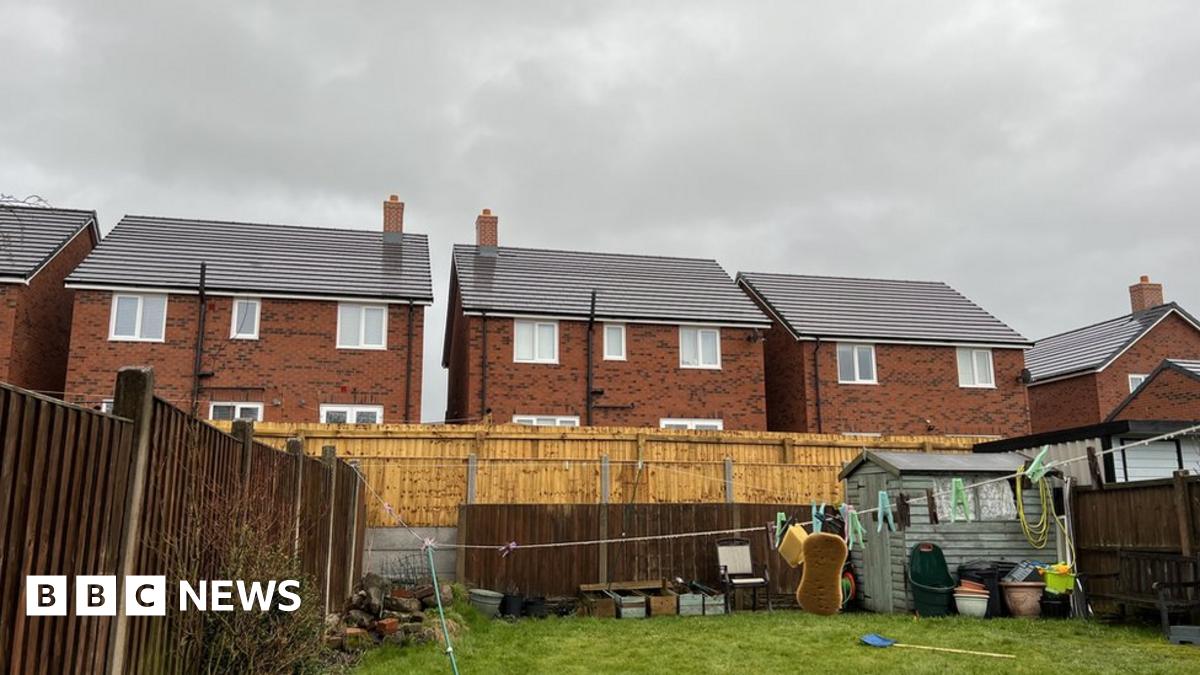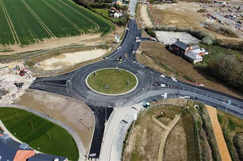TL; DR - I work in the industry and the volume of peak hour traffic from the development is much much smaller than the number of cars own by the households of a development and traffic from a development fragments rather a lot as soon as there's a choice of direction (even if it's a fairly insignificant junction).
There are now, on average, 12 cars for every 10 households. However this only tells part of the story: 22% of households don’t have a car at all but 33% of households have more than one. Car ownership, and multi-car ownership, is as you’d expect focused on the higher socioeconomic groups.
New housing developments are also focused on these groups as they’re the ones who can afford to buy new homes. So yes, a new housing estate of 100 homes probably will add somewhere between 200 and 300 cars to the local roads. The 22% who can’t afford/don’t want a car aren’t the ones who are buying executive new build houses on the edge of town.
You are confusing number of cars with peak hour traffic, take for example my house, we own two cars, however my wife drives to work 3 days a week and will do so between 7am and 8am (where the peak hour is 8am and 9am) and whilst I take the kids to school in the peak hour, I do so by walking. Therefore whilst we own two cars we generate 0 trips in the morning peak.
Our neighbours one side own a car, however they are retired so rarely travel in the peak.
Some who work leave home before 7am and other do so after 9am.
Others WFH so may not leave at all during the working day.
You’ll have to show your working out on this one.
As
@Bald Rick said, it's my experience from working in Transport Planning and Highway Design.
People in these estates are in the higher socioeconomic groups, i.e. at least two people in the household will be in full time work. So 100 houses will result in a minimum of 100 cars leaving the estate in the direction of the main city or employment hotspot, and probably closer to 200 given the way these households are generally multi-car households. Add in the kids driving to college…
Traffic isn't as clean for as you may think. Main cities and employment hotspots are a much smaller draw than you think. In part as often if they have a significant draw there's quite often public transport options.
Add to that, it can be the case that one of those two jobs in a household can be trying to fit in around school/childcare and so may not be a typical 9-5 job. With childcare costing £7 an hour per child (which is after they've paid tax, so means earning about £10 to cover the cost) in some locations, it's not uncommon for people with "9-5 jobs" having some flexibility to reduce the number of hours they need to pay for childcare (for example going in late, WFH, leaving early, or simply just not working 35+ hours a week).
Whilst there will be quite a few who do drive to college, given that at the start of September in their first year almost none will have passed their test and the cost of learning to drive (let alone the cost of car ownership) the numbers are still (compared to the size of the college population) relatively limited. Even then, due to way colleges work not all of them will be traveling in the peak hour.
The problem, of course, is that this hypothetical road will already have 1000 cars on it, so adding another 300 will tip it over the edge.
Even if the road had 1,000 vehicles in one direction and the development was large enough to add 300 vehicles (2 way) in the peak hour (which would be way more than 100 homes, closer to 450) generally it's not the road capacity which is the issue, rather it's the junctions.
Most junctions would typically only need fairly small changes to see them be able to cope with the volume of extra traffic. For example, changing from a simple t-junction to one with a hached right turn lane reduces congestion significantly.
Likewise, adding signals to a junction or a roundabout. Even making the diameter of the roundabout 2m larger can add quite a bit of extra capacity, when it doesn't appear to be overly larger.
However, unless there's almost nothing in one direction (like a road going to two farms) there will almost certainly be some form of split in traffic. Even 5% going the other way reduces the two way flow from 300 to 285 (and 5% would still be to a road which few would appear to wish to use, for example a country lane which doesn't go to anywhere of significance)
Also about 1/3 of traffic heading towards the houses (school traffic returning home, delivery vehicles, waste collection, shift workers, etc).
All told chances are to get to 300 vehicles on a road in one you'd need a development of over 700 homes (assuming that only 5% of traffic goes one way as there's nothing there other way, yet that road wouldn't be carrying 1,000 cars if it did).
Due to that paradox (a road to nowhere of significance carrying 1,000 cars), it's more likely that the development would be for 1,050 homes to have 300 cars in one direction along an already busy road. However, for most developments of that size they would typically be providing school facilities and/or local shops, that will then reduce the need for that traffic to leave the development.
It's also worth noting that once you're into the 1,000 homes or more territory it's almost certain that there'll be more than one road which the development connects to (which means the development would need to be larger still to reach that 300 vehicles in one direction on one road).
That is the problem. Again, taking one of the proposed developments in St Albans (1100 homes north of the city), even one additional trip generated will just add to existing the 2km / 20 minute queue that exists for the peak hour (and only an hour) in the morning.
I don't know the area, however it's not uncommon for such delays to be due to a few key junctions creating a bottleneck. As such, it's possible for the developer's transport planners to identify the constraints and then provide a viable solution to increase capacity.
Where that's not possible, other options come into play. For example 1,100 homes is likely enough to generate a decent number of bus users. If a new bus route is delivered then some existing car users may switch to using the bus. Similarly, if active travel (walking & cycling) improvements are made (and due to the size of the development Active Travel England will be consulted and make recommendations, which developers are generally willing to do as they can seriously block development if they are unhappy) them again some car users could switch to walking and cycling.
Even if the numbers switching to buses and cycling are small it's a number bigger than 0, and each car taken off the road by such a switch, is a car the development can add back and not increase the overall number of vehicles using a road (after the first 2 for each bus they are adding to the road).
That's before you consider the desire for people to go the "wrong way" to where you would expect them to go. (Again this is only me looking at a map) for example many would underestimate the draw of places like Harpendon or even Wheathampstead to split the direction of travel of traffic.
Overall, the impact may not be as large as it would at first appear (bearing in mind what I've said above about the internal traffic if there's schools and/or other facilities on site).
That's not to say that it's not going to cause there to be a need for improvements or even some small increase in congestion in the local area, it's just not going to be as big as issue as some will make out.
It's certainly not going to be adding 2,000+ cars to that queue in question. When you look at the Transportation Assessment for the site I would guess that they would be talking about less than 175 vehicles (and I wouldn't be surprised if it was closer to 100 than that) being on that road where that queue is in the morning peak.
200 vehicles in an hour would be an extra 12 seconds of green time for each 90 seconds of traffic signal cycle time (i.e. from one light going green through to the next time it goes green being 90 seconds). Obviously you can't squeeze more time into 90 seconds, but adding an extra traffic lane (even if that's a turning lane) will allow the length of time that arm needs to get the same amount of traffic through to be reduced.
Sometimes this can be by adding the capacity on a road which isn't the one in question. As by reducing a side road from needing 20 seconds of green time to needing 12 seconds (by adding a, say, left turn lane) you can then give 8 seconds to another arm (8 seconds would be enough for about 140 extra cars an hour).
Sometimes the issue is due to blocking back through a junction from another junction (which can even be off to the side of the main flow, for example if there's a school which creates congestion and stops cars from leaving the main road and queues far enough back to stop/restrict the ahead traffic). That's harder to fix, but again active travel improvements can help (as it makes walking/cycling more attractive, especially if it's to a secondary school).





